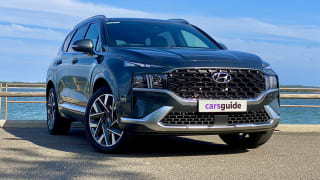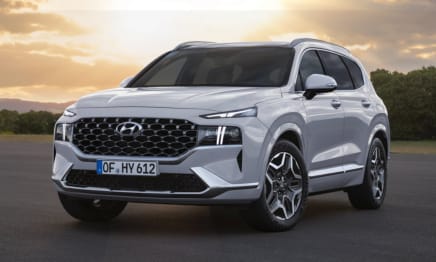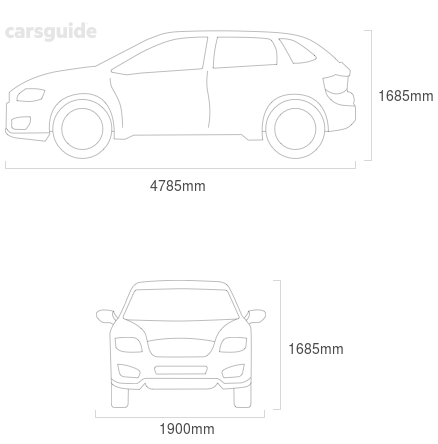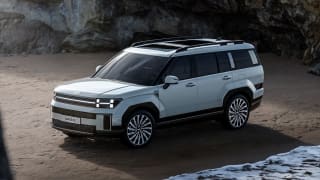
What's on this page
Hyundai Santa Fe 2024
The Hyundai Santa Fe SUV competes with similar models like the Toyota RAV4, Kia Sorento and Mazda CX-9 in the Under $50k category category.
The 2024 Hyundai Santa Fe carries a braked towing capacity of up to 2500 Kg, but check to ensure this applies to the configuration you're considering.
Hyundai Santa Fe Reviews

Hyundai Santa Fe 2023 review: Elite hybrid long-term | Part 3

Hyundai Santa Fe 2023 review: Elite hybrid long-term | Part 2

Hyundai Santa Fe 2023 review: Elite hybrid long-term | Part 1

Hyundai Santa Fe 2023 review: Active diesel long-term | Part 4

Hyundai Santa Fe 2023 review: Active diesel long-term | Part 3

Hyundai Santa Fe 2023 review: Active diesel long-term | Part 2

Hyundai Santa Fe 2023 review: Active diesel long-term | Part 1

Hyundai Santa Fe 2023 review: Hybrid

Hyundai Santa Fe 2023 review: Highlander 2.2D

Hyundai Santa Fe 2021 review: Highlander petrol

Hyundai Santa Fe 2021 review: Highlander

Hyundai Santa Fe Elite vs Kia Sorento Sport+ Review: We Compare the Popular Hyundai & Kia 7 Seater Diesel AWDs
Hyundai Santa Fe 2024 Q&As
Check out real-world situations relating to the Hyundai Santa Fe here, particularly what our experts have to say about them.
-
What's a good hybrid car to buy?
The default purchase for somebody looking for a mid-sized hybrid SUV is the Toyota RAV4 Hybrid. But if that’s too big, there’s the Toyota Yaris Cross Hybrid, C-HR Hybrid and even the Corolla Cross Hybrid which sounds like the marketplace is getting crowded but is really just a reflection of the appetite right now for cars like these. And that’s the catch; the waiting times for a brand-new example of some of these cars is out to many months and even years. So your plan to shop second-hand makes plenty of sense, but don’t expect any bargains in a market currently being dominated by lots of demand and less supply.
Beyond the Toyota brand (which has been doing hybrids longer than just about anybody else) there’s also the Mazda CX-30, Subaru XV Hybrid, Haval Jolion Hybrid, Kia Niro, Subaru Forester Hybrid, Nissan Qashqai e-Power, MG HS, Honda HR-V e and more. For something a bit bigger, try the Kia Sorento or Hyundai Santa Fe hybrids. There are others out there, too, that are probably bigger or more expensive than you need, but it's very much a growing scene in the Australian marketplace.
Show more -
I am looking for an auto transmission wagon or SUV, that tows at least 1500kg and does not have a CVT.
While the CVT is enjoying a bit of a purple patch right now with many car-makers using it for its efficiency benefits, you’re not the only one, Gregg, that doesn’t want to own such a thing. The CVT’s history is littered with failures, although to be perfectly fair, they are a lot better now than they’ve ever been.
But even if you can accept their reliability track record, some owners will just never take to the CVT’s characteristics of allowing the engine to rev up and have the rest of the vehicle catch up. It can feel very alien and it’s hardly a sporty sensation, either.
With all that in mind, you probably should start looking at things like the two-wheel-drive versions of something like, say, the Toyota Kluger or Hyundai Santa Fe. Both are available in two-wheel-drive, both have conventional 8-speed automatic transmissions and both can haul a decent load (2000kg and 2500kg respectively). The Toyota even offers a hybrid driveline, but, sadly for buyers like you, that uses a CVT transmission.
Show more -
My 2014 Hyundai Santa Fe has a transmission fault, what should I do?
I definitely agree that 60,000km is pathetically short for the lifespan of a modern transmission. And if, indeed, the transmission has failed or is showing dramatic wear in that distance, I’d be asking Hyundai to help out with the cost of repairs. Even though the vehicle is out of warranty (by only about a year it would seem) the low kilometres and full factory service history might give Hyundai cause to come to the party on a pro rata basis.
Meantime, don’t hit the panic button yet. The fault could be a much simpler one than you might be imagining and could be something quick and easy to fix. The problem could be as simple as low transmission-fluid level. If the quoted cost to examine the transmission is putting you off, try an independent transmission specialist who should be more than familiar with this unit.
Show more -
Why is my 2007 Hyundai Santa Fe unresponsive when I press the accelerator?
There’s no point giving an engine a double-dose of whatever the manufacturer recommends as the correct amount. And that applies to everything from injector cleaner to windscreen washer fluid. It’s also true that these injector cleaners will sometimes work if the problem is a simple case of a build-up of dirt and gunk that shouldn’t be on the injector, but if the problem is an actual worn injector or some other problem, then all the cleaner in the world won’t help. You’ve asked if the condition might improve with time, and in the case of a dirty injector that is gradually cleaned by these products, then the answer is maybe.
The fact that your engine runs perfectly once warmed up is the interesting part. That suggests that there’s something going on when the engine is first started. Does it start easily? If not, the glow-plugs (which pre-heat the combustion chamber on a diesel) could be malfunctioning. I’d also be checking the fuel delivery pressure as these modern, common-rail diesel engines use very high fuel pressure to work properly. If the injectors aren’t getting the correct pressure from the moment you hit the key, they can run very poorly. That would then lead me to check for a dirty fuel filter and perhaps even the condition of the pump and its regulator. You might even find the problem is related to the turbocharger or even the throttle-by-wire system that is having a temperature-related hissy-fit.
The first thing to do now would be to have the vehicle scanned and, in particular, look out for fault code P0401. This will be logged as a problem with the EGR system, but is often caused by carbon build-up in the engine rather than a problem with the actual EGR valve. This fault code can also be associated with loose turbocharger plumbing which can lead to boost leaks and the sort of sluggish behaviour you’ve noted. Either way, it’s a good clue about where to look. It’s also worth noting that Hyundai was aware of a problem with the engine fuel-filter fitted to engines built around the time of your car. A change of the filter cartridge was a simple fix, so make sure that’s been done on your car. A Hyundai dealership will be able to check if your car was affected and whether it’s been fitted with the new filter.
Show more
Hyundai Santa Fe 2024 Price and Specs
Pricing guides

| Hyundai Santa Fe Model | Body Type | Specs | Price | |
|---|---|---|---|---|
| Active Crdi (awd) | SUV | 2.2L Diesel 8 SP AUTO | $53,750 | |
| Active MPI (2WD) | SUV | 3.5L — 8 SP AUTO | $50,250 | |
| Crdi (awd) | SUV | 2.2L Diesel 8 SP AUTO | $49,550 | |
| Elite Crdi (awd) | SUV | 2.2L Diesel 8 SP AUTO | $60,000 | |
Hyundai Santa Fe 2024 Towing capacity
The Hyundai Santa Fe’s towing capacity ranges from 1650kg to 2500kg. Some models also offer heavy-duty or towing option packs which can increase towing capacity, as well as options which can hamper towing capacity. Towing capacities can vary wildly on a large number of factors. These include engine, transmission, model, and options chosen. Always check with the manufacturer or in your vehicles handbook before attempting to tow anything.
| Hyundai Santa Fe Model | Body Type | Specs | Braked Capacity | |
|---|---|---|---|---|
| MPI (2WD) | SUV | 3.5L,—,8 SP AUTO | 2500kg | |
| Crdi (awd) | SUV | 2.2L,Diesel,8 SP AUTO | 2500kg | |
| Active MPI (2WD) | SUV | 3.5L,—,8 SP AUTO | 2500kg | |
| Active Crdi (awd) | SUV | 2.2L,Diesel,8 SP AUTO | 2500kg | |
Hyundai Santa Fe VS the competition
Hyundai Santa Fe 2024 Dimensions
Dimensions for the 2024 Hyundai Santa Fe are dependent on which body type is chosen. The maximum width and height is 1900mm x 1685mm and can vary on the basis of model.


| Hyundai Santa Fe Model | Body Type | Height x Width x Length | Ground Clearance | |
|---|---|---|---|---|
| MPI (2WD) | SUV | 1685x1900x4785 mm | 176 mm | |
| Crdi (awd) | SUV | 1685x1900x4785 mm | 176 mm | |
| Active MPI (2WD) | SUV | 1685x1900x4785 mm | 176 mm | |
| Active Crdi (awd) | SUV | 1685x1900x4785 mm | 176 mm | |
Hyundai Santa Fe 2024 Fuel consumption
Fuel consumption for the 2024 Hyundai Santa Fe is dependent on the type of engine, transmission, or model chosen. The Hyundai Santa Fe currently offers fuel consumption from 6 to 10.5L/100km. The Hyundai Santa Fe is available with the following fuel types: Diesel and —.
| Hyundai Santa Fe Model | Body Type | Specs | Fuel Consumption | |
|---|---|---|---|---|
| Active Crdi (awd) | SUV | 2.2L,Diesel,8 SP AUTO | 6.1L/100km | |
| Active MPI (2WD) | SUV | 3.5L,—,8 SP AUTO | 10.5L/100km | |
| Crdi (awd) | SUV | 2.2L,Diesel,8 SP AUTO | 6.1L/100km | |
| Elite HEV (7 Seat) | SUV | 1.6L,—,6 SP AUTO | 6L/100km | |
Hyundai Santa Fe 2024 Wheel size
Wheel size for the 2024 Hyundai Santa Fe will vary depending on model chosen, although keep in mind that many manufacturers offer alternate wheel sizes as options on many models.The wheel size available will alter the range of tyres available to be fitted.
| Hyundai Santa Fe Model | Body Type | Front Tyre Size | Front Rim | Rear Tyre Size | Rear Rim | |
|---|---|---|---|---|---|---|
| MPI (2WD) | SUV | 235x65 R17 1 | — | 235x65 R17 1 | — | |
| Crdi (awd) | SUV | 235x65 R17 1 | — | 235x65 R17 1 | — | |
| Active MPI (2WD) | SUV | 235x60 R18 1 | — | 235x60 R18 1 | — | |
| Active Crdi (awd) | SUV | 235x60 R18 1 | — | 235x60 R18 1 | — | |


